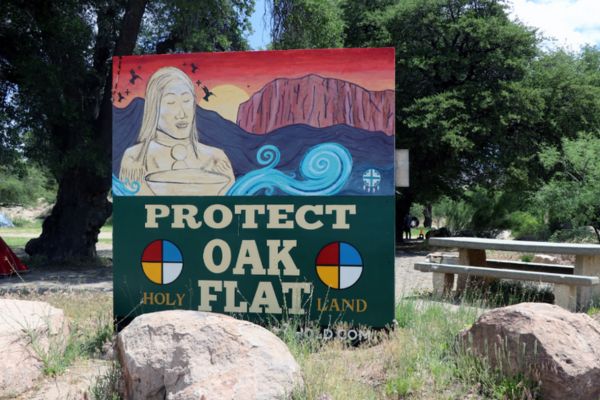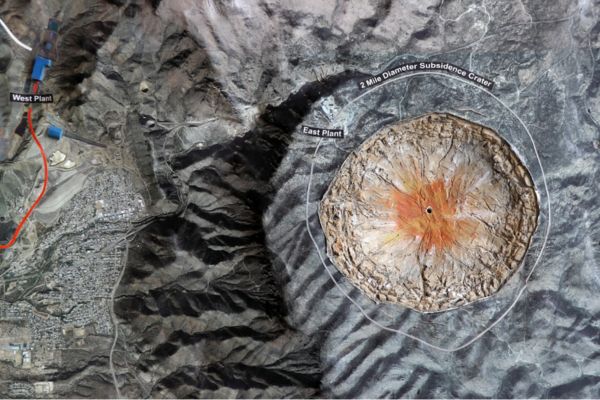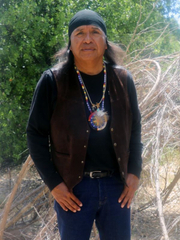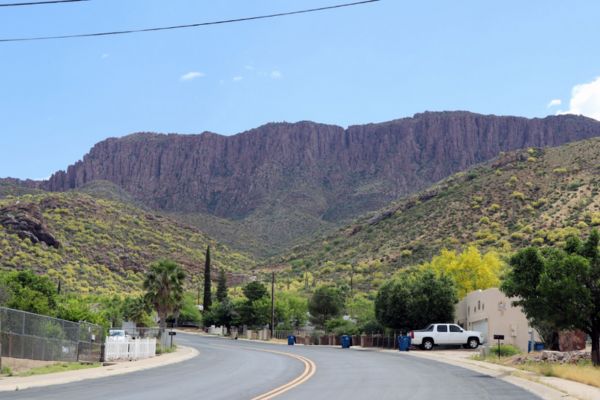
- Details
- By Emma Ricketts, Special to Native News
OAK FLAT, Arizona — On a high plateau in the Tonto National Forest, Wendsler Nosie of the San Carlos Apache tribe lives in a small silver-colored trailer surrounded by tents, picnic tables. and towering oak trees.
This is the Oak Flat campground — a sacred site for thousands of Native Americans and home to what the Rio Tinto mining company claims is one of the largest undeveloped copper-ore deposits in the world, capable of producing 40 billion pounds of copper over the next 40 years.
“Right now, we're sitting in a place where angels reside,” Nosie said while settling into a camping chair under the shade of an oak tree. Christians call them angels, but to the Apache, they are Ga’an people, he explained.
“Here is the creation story of where a woman came to be, and where the holy ones came together,” he continued. “This is where we originated as people.”
This site is threatened by plans to mine copper. The block-cave method proposed by Resolution Copper, the British-Australian mining company owned by Rio Tinto and BHP that has rights to the land, would destroy Oak Flat. It works by undercutting rock, causing the copper ore to collapse into pre-constructed chambers for extraction. It would take place over 40 years and would leave behind a crater that is nearly two miles wide and 1,000 feet deep - almost the height of the Eiffel Tower.
Nosie has spent years of his life working to protect the site through court action and peaceful protest, and he isn’t alone. With 89% of the nation’s copper reserves located within 35 miles of Native American reservations, historically, religiously, and culturally significant lands are in jeopardy across the Southwest.
The confiscation or destruction of sacred Indigenous land is not novel, but increasingly ambitious plans to make the transition away from fossil fuels have spurred unprecedented interest in clean-energy raw materials, and copper is a key component in electricity networks and renewable energy systems. An International Energy Agency scenario estimates that to meet the Paris Agreement’s goals for sustainable development by 2040, the amount of copper used in clean-energy technology would grow to 45% of total demand, almost twice its share in 2020. A 3D model of the proposed mine at Oak Flat shows the crater it will leave - nearly two miles wide and 1000 feet deep. (Credit: Emma Ricketts)
A 3D model of the proposed mine at Oak Flat shows the crater it will leave - nearly two miles wide and 1000 feet deep. (Credit: Emma Ricketts)
A sacred site
The road to the Oak Flat campground is unpaved and winding, full of potholes big enough to warrant swerving. Across the arid landscape, tall oak trees and red-rock formations jut out of the hard-packed dirt. The sun is bright and shaded areas are sparse, but the 100-degree air is cooled by a constant breeze.
Peaceful and quiet, it feels like hours from civilization although it’s only about 40 miles east of Phoenix. Oak Flat, 48 miles west of the San Carlos Apache tribal reservation, is sacred to the San Carlos Apache as well as other Indigenous nations with ties to the area.
Nosie, a former chairman of the San Carlos Apache tribe, moved to the site two years ago to protest the proposed mine. He announced the move in a letter to top officials in the U.S. Forest Service, the federal agency charged with managing the land. “I said I was vacating the reservation and coming home back to Oak Flat because of their negligence,” he said.
Gesturing upwards at the oak trees that produce abundant acorns, Noise said: “Some of these trees are over a thousand years old. They feed people, they feed animals, and they're going to be murdered. I want American people to understand - you will have murdered this place.”
As he said this, a strong gust of wind blew across the plateau, disturbing grasses and rattling tents. “You see what I mean?” Nosie asked, after a long minute of silence. “Spirits move. You have to be here to understand.”
Balancing priorities: critical minerals for a green-energy transition
The copper below Oak Flat was discovered in the early 1990s. Congress granted Resolution Copper rights to acquire the land in 2014, after the late Senator John McCain (R-Ariz.) attached a rider authorizing that to a defense appropriations bill.
Nosie remembers that night clearly. He had spent years campaigning against similar laws and land exchanges. After hearing rumors that it might be introduced in the late afternoon, he received confirmation it had passed around 11 p.m.
He stayed awake all night trying to come to terms with the outcome, he said. He thought of his tribe’s elders and children - including those yet to be born. Who would protect them against the mine’s impacts and the loss of this religious ground?
According to the legislation, the land will be transferred from the Tonto National Forest to Resolution Copper within 60 days after an environmental impact statement is released. This statement must identify measures to minimize adverse effects on cultural resources and the environment.
The stakeholders are still waiting. An initial impact statement, published in January 2021, was withdrawn when President Joseph Biden took office. The Forest Service told the Ninth Circuit Court of Appeals in April that it would delay release of an updated version pending consultation with the affected tribes.
Nosie dismissed the proposed consultation as meaningless. “[The government] has to go ahead anyway, consultation is just checking a box,” he said. The legislation requires the land’s transfer regardless of the statement’s findings.
Resolution Copper disputed this perspective. “Over the past decade, the information collected and the two-way dialogue with Native American Tribes and communities have helped significantly reshape the project,” it said in a written statement to Native News Online, adding that planners have altered the location of major facilities to avoid dozens of areas of cultural significance after those consultations.
 Wendsler Nosie. (Photo/Emma Ricketts)A wider issue
Wendsler Nosie. (Photo/Emma Ricketts)A wider issue
Oak Flat’s land transfer is governed by bespoke legislation passed by Congress, but Nosie’s fight reflects a challenge facing dozens of Indigenous communities in the Southwest.
The key law governing hard-rock mining was enacted in 1872, under President Ulysses S. Grant. It is outdated and heavily favors mining interests, said Blaine Miller-McFeeley of the environmental-law organization Earthjustice.
“A mining company can go, put four stakes in the ground, then head to the local Bureau of Land Management or Forest Service Office and hand them $150 and a few pieces of paper,” he explained. “Because of the way the [federal government] has interpreted the mining law for 150 years, they cannot deny the company or the person, so long as there are valuable minerals underneath where they put their stakes.”
Numerous attempts to amend the law have failed. “All the core pieces of the [1872 Act] are still in place,” Miller-McFeeley said. “The discretion, the lack of environmental standards … none of those core things have changed.”
However, Tim Crowley, vice president of government and community relations at the Lithium Americas mining company, said the 1872 mining law was never intended to protect Indigenous and environmental interests, and it should not be expected to do so.
“What gets lost in the sound bites is that U.S. laws and state laws have progressed,” he continued. “The mining law was never designed to be an environmental or a cultural protection law - that's why the Clean Air Act, the Clean Water Act, National Environmental Protection Act, and the Historic Preservation Act continue to evolve.”
Lithium Americas started construction on a lithium mine at Thacker Pass, Nevada, in March. A February court ruling denied an allegation that it would violate local tribes’ right of access to historically and culturally significant sites.
The mine is going ahead, and Indigenous interests are being protected, Crowley said. There was evidence of Native Americans making obsidian tools at the Thacker Pass site, for example, so these artifacts have been cataloged and treated in compliance with the Historic Preservation Act, he added. According to Crowley, Lithium Americas has also employed cultural monitors from the nearby Fort McDermitt Tribe to observe their work.
However, Will Falk, an attorney for the Reno-Sparks Indian Colony and the Summit Lake Paiute Tribe, says the laws are insufficient to meaningfully protect indigenous sites. Both of the tribes he represents are working to stop the Thacker Pass mine as well. The laws, he says, exist, “but they aren’t strong.”
Construction is moving forward on the mine, but local indigenous communities are continuing to fight back with non-violent protests, rallies and grassroots activism.
“If a company wants to mine underneath a sacred place and native communities say ‘hell no’, then it should be ‘hell no’,” Falk added. “But the American economy is completely based on extraction, and anyone who thinks that politicians, elected representatives or the courts are going to seriously impede the mining industry must be on drugs.”
Last year, the Ninth Circuit upheld a challenge by the Tohono O’odham Nation, the Pascua Yaqui Tribe, and the Hopi Tribe to the Forest Service’s approval of an open-pit copper mine in Arizona’s Santa Rita Mountains. It ruled that while the 1872 law authorizes mining for valuable minerals on public lands, it does not permit dumping mine waste on public land, saying that the Forest Service had disregarded “a century of precedent.”
But opponents argue these protections are superficial. “We totally support clean energy, but you need to think about the environment,” said Martina Dawley, a senior archeologist and member of the Hualapai tribe in Arizona. Her tribe is currently negotiating with the Bureau of Land Management to protect sacred and ancestral lands from a proposed lithium mine, she added.
In her view, alternatives like recycling warrant more attention. “From an Indigenous perspective, you never over-harvest and you don't destroy your resources,” she said. “You only take what you need and you make sure everyone can have some of that.”
Crowley countered that there’s not yet enough used lithium available for recycling to be viable. Lithium Americas could “absolutely” play a role in recycling in the future, he said, “but right now, we are 40 years away from recycling making a meaningful dent in supply.”
 Oak Flat is a plateau atop a 3,900 foot hill in the Tonto National Forest, seen here from the town of Superior, Arizona. (Photo/Emma Ricketts)
Oak Flat is a plateau atop a 3,900 foot hill in the Tonto National Forest, seen here from the town of Superior, Arizona. (Photo/Emma Ricketts)
The cost of clean energy
Henry Muñoz stood on the shoulder of the winding, uphill road leading to Oak Flat. He used to bike up here as a child and cool off in the valley’s swimming holes.
Muñoz is a retired miner, a resident of Superior, Arizona, and a member of the Concerned Citizens and Retired Miners Association. Surrounded by towering rock formations, he peered over a guardrail towards a deep canyon that winds its way back towards the town of Superior. He does not oppose mining in general; he spoke bluntly about the need for materials to make the transition away from coal and oil. But he does oppose the method and location of Resolution Copper’s proposed copper mine.
“Do we have to pollute areas so that others can flourish?” he asked. According to Muñoz, the block-cave mining method will cause irreversible damage. “There will be no turning back. You can’t refill the hole with anything, because the ground is constantly going to be caving in below it. It's like an underground earthquake that doesn't stop.”
Muñoz first became interested in the Oak Flat mine through concern for his town’s water supply. Now retired, he has dedicated a significant amount of time to educating his community about the risks.
The now-rescinded 2021 environmental impact statement showed that the mine will affect 18 to 20 groundwater-dependent ecosystems - including the aquifers, springs, and ponds that feed local communities, he said.
Resolution Copper claims to have developed plans to protect these waterways. “There will be no physical impact to Devil’s Canyon or Queen Creek … Resolution Copper will forgo portions of copper-bearing ore to minimize subsidence impacts to these important areas,” the company’s statement read. A spokesperson declined to give any further details.
Mining history across the U.S. has consistently shown such promises to be superficial. Communities from Oklahoma to Colorado, California, and Vermont are dealing with irreversible effects on their waterways. The Associated Press, looking at 43 mine sites in 2019, estimated that they discharged an average of more than 50 million gallons a day of water contaminated with arsenic, lead, and other toxins.
Regardless, said Nosie, these environmental concerns are irrelevant to the fate of Oak Flat. As noted above, the land must be transferred within 60 days of the environmental impact statement irrespective of its findings.
Instead, Nosie’s grass-roots organization, Apache Stronghold, has pursued a lawsuit based on religious freedoms. In 2021, they sought a federal court injunction against the land being transferred to Resolution Copper, with arguments relying on the Religious Freedom Restoration Act, which forbids the government from substantially burdening another person’s exercise of religion.
The federal district court ruled against them and the Ninth Circuit rejected their appeal, but in late 2022, the appeals court agreed to rehear the case with a full panel of 11 judges. Oral arguments were presented in March, and the parties are awaiting judgment.
The religious-freedom law has never been applied to a Native American religion, and Nosie is anxious to see how it will play out. It is about much more than a copper mine, he said: It is an opportunity for America to start healing the scars created by colonization.
No matter the outcome, he expects either party will appeal to the Supreme Court. “This case is going to set the precedent for what’s going to happen next. If we lose it and the system and the people fail us, it will be a free-for-all. But if the system fails us and the people don’t, healing is coming. And if the system and the people help together, it’s coming quicker.”
Emma Ricketts reported this story as a graduate student at Northwestern’s Medill School of Journalism, where she specialized in Politics, Policy and Foreign Affairs. Prior to Medill, she practiced as a lawyer in New Zealand focusing on climate-related risk and public law issues.
Help us defend tribal sovereignty.
At Native News Online, our mission is rooted in telling the stories that strengthen sovereignty and uplift Indigenous voices — not just at year’s end, but every single day.
Because of your generosity last year, we were able to keep our reporters on the ground in tribal communities, at national gatherings and in the halls of Congress — covering the issues that matter most to Indian Country: sovereignty, culture, education, health and economic opportunity.
That support sustained us through a tough year in 2025. Now, as we look to the year ahead, we need your help right now to ensure warrior journalism remains strong — reporting that defends tribal sovereignty, amplifies Native truth, and holds power accountable.
 The stakes couldn't be higher. Your support keeps Native voices heard, Native stories told and Native sovereignty defended.
The stakes couldn't be higher. Your support keeps Native voices heard, Native stories told and Native sovereignty defended.
Stand with Warrior Journalism today.
Levi Rickert (Potawatomi), Editor & Publisher
